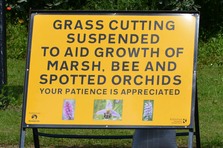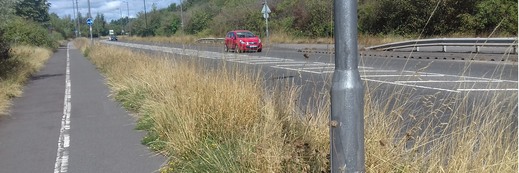

Biodiversity
Action
Plan
Road verges suffer from road-widening, pipe-laying, littering and fly-tipping, salt contamination and pollution from road traffic.
They have also suffered by becoming too nutrient-rich and as a consequence, when unmanaged, becoming overgrown with rampant tall grasses and encroached by brambles, bracken, nettles and scrub.
A lack of management, too much or ill-timed mowing, and cuttings being left on the verge, reduces biodiversity.
Fewer and later cuts give grasses and flowers chance to set seed whilst providing cover and food for small mammals and invertebrates.
Where the priority is highways safety or providing a route for pedestrians or horses, verges may be cut frequently to provide a low sward. Steps can be taken even with shorter grass to support wildlife.
Grassland Verges
Verges alongside roads, tracks and pathways can support a wide range of grasses and flowering plants, and be good for wildlife.
They provide a wildlife corridor and are sometimes an important grass-land habitat in their own right. Hedgerows, scrub and ditches alongside the verge may provide additional support for wildlife.
Over 100 plant species recorded on verges near RSPB Old Moor
Some verges have the grasses and dwarf shrubs of acid grassland or heath; others the flowers of neutral grassland.
Some are specially seeded to produce grass quickly or with a mix to produce wild flowers.
When not cut, long tussocky grasses of undisturbed verges provide cover for small mammals and birds which feed on seeds and invertebrates there.
In some verges the grass has given way to scrub, bushes and trees which can provide their own support for wildlife.
Verges with short grass cut more frequently, will support low growing flowering plants and plants that set their seed before the first cut.
Summer flowering plants need time to seed; they disappear as a result of early cuts.
Nutrient-rich verges tend to produce more rampant grasses to the exclusion of flowering plants other than Cow Parsley.
Verges can be managed to keep the wild flowering plants which are important for pollinators and enrich the countryside.
Over-planting rural grass verges with garden plants like daffodils may be seasonally attractive but overall will reduce biodiversity.
In urban areas road verges and central reservations may some-times be planted with annual and perennial seed mixes to create a colourful display of flowers and benefit pollinating insects.


People can be kept ‘on-side’ by telling them of the benefits of longer grass for wildlife through informative signs.
A link below leads to information on different options for managing grass verges.
A lack of resources may mean that mowing in the appropriate season is difficult to achieve.
However some changes that are desirable for biodiversity, like less frequent mowing, can help conserve resources as well.

A roadside verge often includes
- a ‘splash zone’ at the road edge where plants tolerate being splashed with dirt or sprayed with salt in winter
- a strip mown regularly to provide sight lines with low-growing grasses and flowers
- At the back an area of longer grass cut less frequently.
- Some verges remain uncut for a year or so, if not cut at all, scrub, bramble, etc develop.
Grassland Verges